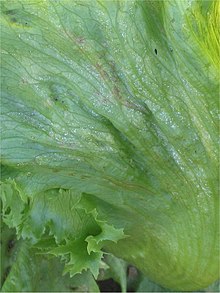Bremia lactucae
| Bremia lactucae | |
|---|---|

| |
| Iceberg lettuce infected with Bremia lactucae | |
| Scientific classification | |
| Clade: | SAR |
| Phylum: | Oomycota |
| Order: | Peronosporales |
| Family: | Peronosporaceae |
| Genus: | Bremia |
| Species: | B. lactucae
|
| Binomial name | |
| Bremia lactucae Regel, Bot. Ztg.: 666 (1843)
| |
| Synonyms | |
|
Botrytis gangliformis Berk. [as 'ganglioniformis'], (1846) | |
Bremia lactucae is a plant pathogen. This microorganism causes a disease of lettuce (Lactuca sativa) denominated as downy mildew. Some other strains can be found on 36 genera of Asteraceae including Senecio and Sonchus. Experiments using sporangia from hosts do not infect lettuce and it is concluded that the fungus exists as a quantity of host-specific strains (formae speciales). Wild species, such as Lactuca serriola, or varieties of Lactuca can hold strains that infect lettuce, but these pathogens are not sufficiently common to seriously infect the plant.
The severity of damage caused by Bremia can vary depending on environmental conditions. High humidity and cool temperatures are optimal for infection and spread of the disease.
The first symptoms appear as slightly chlorotic local lesions on lower leaves, eventually turning yellow and necrotic after the onset of sporulation. Lesions are angular and limited by large veins of the leaf. Systemic infections are known to occur, and symptoms include elongated discolored regions on the leaves, turning from dark green to brown, and dark brown/black streaked regions within the stem and roots. Lettuce that is infected with downy mildew causes the plant to become more susceptible for other pathogens. The infected leaf tissue can serve as an entry for secondary infection, particularly to pathogens that cause soft rots such as, Botrytis cinerea.
Systemic fungicides such as Metalaxyl and Fosetyl-Aluminum have lost much of their efficacy as a control of B. lactucae due to its high genetic variability and ability to rapidly develop resistance. The most effective management practice of downy mildew is to use resistant cultivars of Lettuce. Resistance genes are defined by a gene-for-gene relationship, and there are over 27 known resistance factors matching virulence factors in B. lactucae. Another management technique is minimizing leaf wetness by using an irrigation system that is in the ground as opposed to a sprinkler system, which is favorable for infection. Other practices include removing infected plant debris from soil and application of fungicide.

Description[]
- Coarse intercellular mycelium.
- Haustoria are sac-shaped, many times they are present in each host cell.
- Sporangiophores emerge singly or in small groups through the stomata and branch dichotomously.
- Tip of each branch expands to form a cup-shaped disc bearing short cylindrical sterigmata at the margin and occasionally in the centre, and from these the hyaline sporangia arise.
- Germination of the sporangia is usually by means of a germ tube which forms an appressorium to penetrate epidermal cells or it enters through a stoma.
- Zoospores are found in some downy mildew species, but not B. lactucae.
- Sexual reproduction is usually heterothallic, but homothallic strains also exist.
- Oospores have rarely been observed in nature, but are abundantly produced in cotyledons and leaves after artificial inoculation with both mating types; ideal conditions for oospore germination remains unclear.
- Oospores found in leaf debris act as the primary inoculum for new infection. They can remain viable in the plant tissue for up to 12 months.
References[]
- Introduction to fungi. Webster. 3rd edition (2007). Cambridge University Press. ISBN 978-0521014830
- Crute, I. R. (1984). The integrated use of genetic and chemical methods for the control of lettuce downy mildew (Bremia lactucae). Crop Protection,3, 223-242.
- Crute, I. R. & Dixon, G. R. (1981). Downy mildew diseases caused by the genus Bremia. In The Downy Mildews, ed. D. M. Spencer. London: Academic Press, pp. 421-460.
- Michelmore, R. W. & Ingram, D. S. (1980). Heterothallism in Bremia lactucae. Transactions of the British Mycological Society, 75, 47-56.
- Morgan, W. M. (1983). Viability of Bremia lactucae oospores and stimulation of their germination by lettuce seedlings. Transactions of the British Mycological Society, 80, 403-408.
- Subbarao, K. V., Davis, R. M., Gilbertson, R. L., and Raid , R. N. Raid. Compendium of Lettuce Diseases and Pests, Second Edition. 2016. https://doi.org/10.1094/9780890545782
External links[]
- Bremia lactucae at Index Fungorum
- USDA ARS Fungal Database
- "Friday Fellow: Downy Mildew" at Earthling Nature.
- Peronosporales
- Water mould plant pathogens and diseases
- Lettuce diseases
- Water mould stubs
- Plant disease stubs
